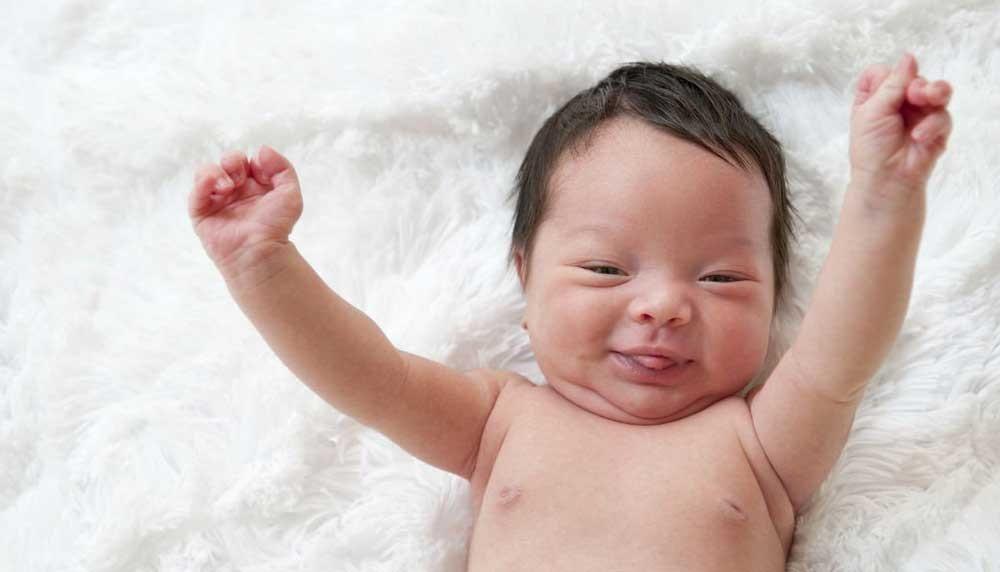BABY
Baby Reflexes: Brilliant Things Your Newborn Can Do Automatically
Amazing instincts every child knows from birth.

Written by
Dr. Harvey Karp

SHARE THIS ARTICLE
PARENT PICKS
Bestsellers
BABY

Written by
Dr. Harvey Karp

SHARE THIS ARTICLE
Bestsellers
Imagine trying to teach your baby how to suck or poo. Thankfully, you do not have to because babies are born with about 70 newborn reflexes tucked away in their jam-packed brains. Like blinking or coughing, infant reflexes are automatic behaviours that do not have to be learned or practiced. Many newborn reflexes are so important that they are present from day one of life…and before!
You will have fun catching your baby showing off some of these amazing tricks. Here are several different infant reflexes to watch for:
Crying is the ‘mother’ of all baby safety reflexes! Triggered by any sudden distress, it is perfectly tuned to launch your nervous system and get your heart—and feet—racing to help.
We often think of sneezes as a sign of a cold, but with babies they are usually just little noses trying to eject bits of dust and mucus.
Rooting reflex is a natural reflex displayed by your baby when they automatically turn their face towards stimulus and make sucking motions when the lips or mouth are touched.
Touch your baby’s cheek near the lips (or right on the lips) and his mouth will turn toward the touch, open and then shut. Rooting helps your baby locate, receive and grasp your nipple…even in the dark. Do not worry if you stroke the cheek and your baby does not respond. Rooting is a smart reflex: It is only there when an infant is hungry. If you touch his cheek and nothing happens, he is probably not needing a meal yet.
Do you have ultrasound photos of your little cutie sucking his thumb before birth? After your baby roots and latches onto the nipple, sucking and swallowing get flipped on to send milk down the stomach.
Hold your baby under the armpits (slightly leaning forward) and let the soles of his feet touch the floor. A few times out of ten, you will see one leg straighten and the other bend. (Try leaning your baby a little to one side, so one foot has more pressure under it than the other.) During the last months of pregnancy, it may have allowed him to move around and prevent pressure sores.
While the calming reflex soothes upset infants, it probably evolved to calm fussy foetuses! (If foetuses wiggle around too much they can move into breech position and get stuck as they start coming down the birth canal). How brilliant of Mother Nature to make the natural sensations of the womb put babies into a mini-trance for the last 2 months of pregnancy to keep them from moving into risky positions. The 5 S’s (swaddling, side/stomach position, shushing, swinging, and sucking) and SNOO (a baby cot that uses the S's to aid sleep) both turn on the calming reflex.
Press your finger into your baby’s palm or sole of his foot, and he will usually grab on with his fingers or toes. This may seem like a trivial little parlor trick, but it is actually critically important…for baby apes. Newborn chimps have been able to cling to their mum’s fur while she is scurrying through the jungle. (Be careful. Your baby’s iron grip can yank off your glasses or a handful of ‘fur’ off Daddy’s chest!)
At birth, grabbing is a normal reflex, but by 3 months your baby will actively be trying to grab anything in their vicinity.
This is the famous ‘I am falling’ reflex or startle reflex. It flips on when a baby gets startled (by a jolt, loud noise, or her head suddenly falling back). The Moro reflex causes your baby’s arms to shoot open, then come together in a big hug, as if he is trying to grab hold of you. It has probably saved countless baby monkeys whose mums were able to catch their out-stretched arms as they started to fall.
As your baby matures, his clunky old reflexes will be retired and forgotten, like a toddler’s tattered old blankie. But, early in life, many of these well-designed responses are literally life-saving.
Disclaimer: The information on our site is NOT medical advice for any specific person or condition. It is only meant as general information. If you have any medical questions and concerns about your child or yourself, please contact your health provider. Breastmilk is the best source of nutrition for babies. It is important that, in preparation for and during breastfeeding, mothers eat a healthy, balanced diet. Combined breast- and bottle-feeding in the first weeks of life may reduce the supply of a mother's breastmilk and reversing the decision not to breastfeed is difficult. If you do decide to use infant formula, you should follow instructions carefully.